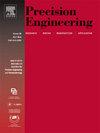Trajectory optimization of the center-inlet elastic polishing tool for uniform material removal and mid-spatial frequency error suppression on optical elements
IF 3.5
2区 工程技术
Q2 ENGINEERING, MANUFACTURING
Precision Engineering-Journal of the International Societies for Precision Engineering and Nanotechnology
Pub Date : 2025-04-30
DOI:10.1016/j.precisioneng.2025.04.031
引用次数: 0
Abstract
To acquire uniform material removal and suppress mid-spatial frequency error of optical elements applied to laser devices, this paper proposed a combined processing scheme based on the center-inlet elastic polishing tool, which is an important component in the computer controlled optical surfacing process. Considering the special structure of the polishing tool, a material removal model under a continuous feed state was established. Trajectory optimization strategy integrating path distance analysis with a novel layered reshaping method was proposed. The optimized path distance significantly enhances material removal uniformity, while the proposed depth-controlled layered reshaping effectively suppresses mid-spatial frequency error caused by excessive path repetition. In addition, a high-precision offline simulation platform demonstrating exceptional predictive capability was established, which achieved less than 10 % deviation between simulated and experimental removal profiles. The experimental results show that the surface roughness Sa and Ra of the samples were improved by 89.4 % and 94.9 % through the combined processing scheme, respectively, while the curve of PSD decreased obviously, which indicates that the mid-spatial frequency error was effectively suppressed. The demonstrated consistency between simulation predictions and physical processing outcomes establishes a valuable reference for precision optical elements’ process optimization.

中心进气弹性抛光刀轨迹优化及光学元件中频误差抑制
为了获得均匀的材料去除和抑制应用于激光器件的光学元件的中频误差,本文提出了一种基于中心入口弹性抛光工具的组合加工方案,该工具是计算机控制光学表面加工过程中的重要组成部分。考虑抛光工具的特殊结构,建立了连续进给状态下的材料去除模型。提出了将路径距离分析与一种新的分层重构方法相结合的轨迹优化策略。优化后的路径距离显著提高了材料去除的均匀性,而深度控制的层状整形则有效抑制了路径重复过多导致的中频误差。此外,建立了一个具有卓越预测能力的高精度离线仿真平台,模拟和实验去除曲线之间的偏差小于10%。实验结果表明,复合处理方案使样品的表面粗糙度Sa和Ra分别提高了89.4%和94.9%,PSD曲线明显减小,有效地抑制了中频误差。仿真预测结果与实际加工结果的一致性为精密光学元件的工艺优化提供了有价值的参考。
本文章由计算机程序翻译,如有差异,请以英文原文为准。
求助全文
约1分钟内获得全文
求助全文
来源期刊
CiteScore
7.40
自引率
5.60%
发文量
177
审稿时长
46 days
期刊介绍:
Precision Engineering - Journal of the International Societies for Precision Engineering and Nanotechnology is devoted to the multidisciplinary study and practice of high accuracy engineering, metrology, and manufacturing. The journal takes an integrated approach to all subjects related to research, design, manufacture, performance validation, and application of high precision machines, instruments, and components, including fundamental and applied research and development in manufacturing processes, fabrication technology, and advanced measurement science. The scope includes precision-engineered systems and supporting metrology over the full range of length scales, from atom-based nanotechnology and advanced lithographic technology to large-scale systems, including optical and radio telescopes and macrometrology.

 求助内容:
求助内容: 应助结果提醒方式:
应助结果提醒方式:


